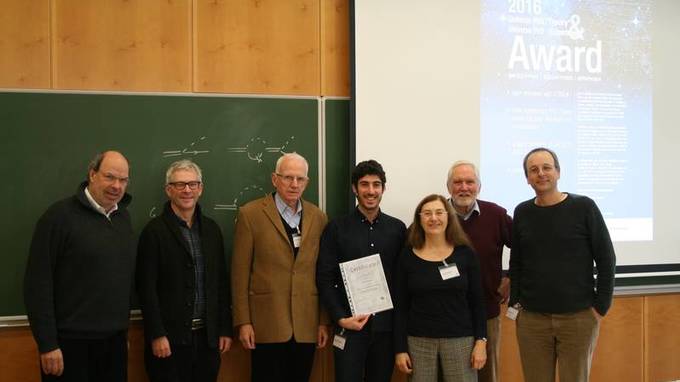Der Inhalt dieser Seite ist leider nur auf Englisch verfügbar.
Excellent PhD theses 2016 at the Universe Cluster
2017-12-07 – News from the Physics Department
Award for Alexander Neumeier’s thesis
Liquid noble gases are attractive detector materials for large astrophysical experiments searching for dark matter, neutrino-less double beta decay or exotic neutrinos. Measurement of the ionization charge and of the scintillation light created in the medium enable particle identification. Pure argon and xenon-argon mixtures are favourable with respect to detection efficiency, sensitivity and cost.
In his experiments Alexander Neumeier bombarded a scintillation cell with 12-keV electrons from a cathode ray tube and detected the emitted light with photomultipliers and diodes. His choice of detectors with different wavelength sensitivities led to the first complete overview of the broad spectral range from ultraviolet to infrared (120 to 3500 nanometers). By carefully controlling tiny (ppm) admixtures of xenon, he proved that the transparency of pure liquid argon was previously underestimated by a factor of two. Variations of the line structure in the ultraviolet range of the spectrum turn out to depend sensitively on the xenon concentration. The same is found for the intensity of his new infrared line. Neumeier presents a convincing interpretation of these phenomena in terms of a rather efficient energy transfer from argon to xenon.
The rich harvest of this outstanding experimental work is reflected by a series of four papers with Alexander Neumeier as first author. Three of these were selected by the journal Europhysics Letters as “editor’s choice”, one additionally as “highlight paper 2014”. The Universe Cluster is also pleased to have supported this work by a 53.000 Euro grant from its “seed money project” budget.
Award for Simone Biondini’s thesis
The matter-antimatter asymmetry is one of the most challenging and exciting problems in our present understanding of the cosmos. In principle there is a mechanism within in the Standard Model (SM), which could explain an asymmetry of this type. However, the size of the corresponding effect is much too small to account for the results of modern experiments based on the Cosmic Microwave Background or the Big-Bang nucleosynthesis.
It is evident that a new mechanism beyond the SM is necessary to explain these facts. Indeed, several such mechanisms have been proposed in the literature. Simone Biondini has chosen for his investigations the fascinating process of baryogenesis through leptogenesis. Very heavy sterile right-handed neutrinos provide a source for the symmetry violation. Because of their large mass they freeze out at a much earlier stage of the cooling process of the early universe and, in this way, considerably enhance the asymmetry between matter and antimatter.
In this context one has to describe the dynamics of heavy Majorana neutrinos in a thermal bath and the resulting symmetry violation. Within the conventional framework of thermal field theory this requires extremely complex calculations, which have not been carried out to date. Simone Biondini therefore proposes a new and very elegant method: an effective field theory for heavy neutrinos based on a separation of scales. He has shown that this method provides an excellent approximation in cases where conventional calculations are possible and gives good reasons to assume that it will also work in more complicated cases. In this way he has, for the first time, been able to calculate the CP asymmetry at finite temperature. This is an important step in our understanding of the early universe.
The thesis of Simone Biondini is an original, important and well-written contribution to a very topical and exciting question. It has resulted in several well-cited publications and has been presented at several conferences.
